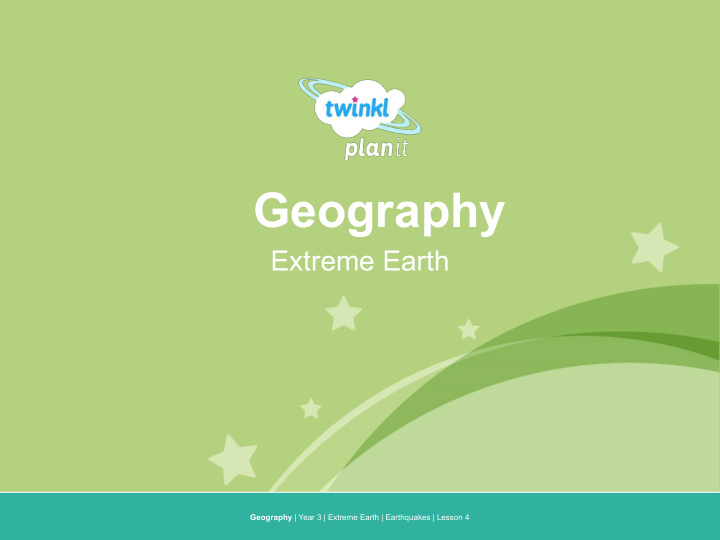



Geography Extreme Earth Year One Geography | Year 3 | Extreme Earth | Earthquakes | Lesson 4
Aim Aim • Describe and understand key aspects of physical geography in the context of earthquakes. Success Criteria Success Criteria • Statement 1 Lorem ipsum dolor sit amet, consectetur adipiscing elit. • I can tell you where earthquakes happen. • I can explain why earthquakes happen. • Statement 2 • Sub statement • I can tell you how to keep safe in an earthquake. • I can compare the strength of earthquakes.
How Do Tectonic Plates Move? Use the two pieces of paper you have been given. Can you remember the different ways you can move the plates around? Rubbing together Towards each other Away from each other This kind of movement causes earthquakes.
Why Do Earthquakes Happen? Earthquakes can cause a lot of damage because they make the ground shake! • Roads can be damaged. • Cracks might appear in the ground. • Things can fall off • Buildings can be shelves. damaged or destroyed. • Pictures can fall off walls. • Furniture can move. • Trees and telegraph poles might sway.
Where Do Earthquakes Occur? Look at this map of the world. Toggle the buttons to show tectonic plate boundaries and earthquake hotspots. What do you notice about where earthquakes happen? Compare the earthquake map to the tectonic plates map. Are there any show tectonic hide tectonic show earthquake hide earthquake similarities? plate boundaries plate boundaries hotspots hotspots
What Should You Do? Drop, Cover and Hold Duck under a strong table or desk. Cover your head and neck with your arms. Stay away from windows. Stay Calm Keep calm. Make safe choices for yourself and those around you. Stay Put Shelter in place. Whether you’re in a car, in bed, or in a public place. Do not try to run out of the building during strong shaking, wait until the shaking stops.
How Strong Is It? There are two main ways to measure the power of an earthquake. Machines called seismographs measure the power of an earthquake at its epicentre on a scale called the Richter scale. Another measure is the Mercalli scale, and this is based on people’s observations during an earthquake. Can you sort out the different strengths of the Mercalli scale into the right order?
Did You Remember What to Do? Drop, Cover and Hold Duck under a strong table or desk. Cover your head and neck with your arms. Stay away from windows. Stay Calm Keep calm. Make safe choices for yourself and those around you. Stay Put Shelter in place. Whether you’re in a car, in bed, or in a public place. Do not try to run out of the building during strong shaking, wait until the shaking stops.
Did You Remember What to Do? •How did you feel when you heard the noise? •Would you feel the same if you were in a real earthquake? •How long did our earthquake last?
Comparing Earthquakes Mercalli Intensity Effect I Felt by no-one. II Felt by very few people. Hanging objects may swing. III Felt by many but they don’t realise it is an earthquake. IV Felt indoors by most people. Vibrations similar to a lorry hitting a building. Felt by nearly everyone. Sleeping people may be woken. Trees and telegraph poles V sway. VI Felt by all. People run outside. Furniture moves. Slight damage to property. VII Felt by all. People run outside. Moderate damage to buildings VIII Specially designed buildings damaged, others collapse. IX All buildings damaged. Cracks appear in ground. X Many buildings destroyed. Ground is badly cracked. Almost all buildings destroyed. Wide cracks in the ground. Water, gas and electric XI out of action. XII Total destruction. Waves seen on the ground.
Aim Aim • Describe and understand key aspects of physical geography in the context of earthquakes. Success Criteria Success Criteria • Statement 1 Lorem ipsum dolor sit amet, consectetur adipiscing elit. • I can tell you where earthquakes happen. • I can explain why earthquakes happen. • Statement 2 • Sub statement • I can tell you how to keep safe in an earthquake. • I can compare the strength of earthquakes.
Recommend
More recommend